Raspberry Pi is the most popular SBC – Single-Board Computer around the world. It can do pretty much everything a desktop computer can do and is suitable for all ages keen to explore computing. Raspberry comes with all the software; you require for basic computing. But if you want to extend the functionalities to some extent, you will need to take OS running on your device.
It performs as a bridge between the user and Raspberry hardware. OS is the most crucial program that helps you to develop and execute programs. It enables the hardware to communicate with the software to generate meaningful interactions. Also, it manages CPU, memory, disk drives, and printers, establishes user interface, and provides services for applications software.
Although Raspbian is the official Raspberry Pi OS, other alternative operating systems are available to run on the Raspberry Pi projects.
Best Raspberry Pi OS

Raspbian and other operating systems like OpenELEC, OSMC, and RISC OS are responsible for making the Raspberry system so popular among developers. You should choose the most suitable operating system for you from the top Raspberry Pi OS list below.
1. Raspbian
This is the official OS, and it can be used on all models of Raspberry. This free operating system is the modified version of the popular Debian. It can serve all the general purposes of Raspberry users. One can indulge in any project development or prototype building and expect any support from this OS.
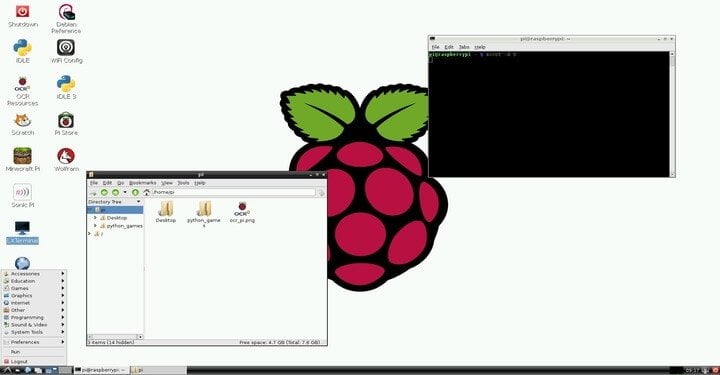
Insights of Raspbian OS
- You can install the setup wizard that allows users to set up a new password and username and connect to a wifi network.
- Overcome the Pi devices’ popular security concern known as the Pi/raspberry and eliminates the hassle of going online.
- Due to the difference in specification, many applications do not run on all Raspberry models, but Raspbian has filled this gap.
- The Recommended Software Tool allows you to download any software if you are connected to the internet whenever you need it.
- Offers features like searching, toolbars configuration, key layout shortcuts, thumbnails, and multi-page controlling with the newly introduced tool qpdfView.
- Preboot eXecution Environment has enabled users to boot their Raspberry using a central server through ethernet.
2. DietPi
If you are looking for an extremely light Debian OS, dietPi might be the best choice. It can be referred to as 3x lighter than the other Raspberry Pi OS available out there. Besides, the installation is effortless and automated. If you configure dietpi.txt before powering on, no user input will be required.
Insights of DietPi
- Diet Processing Tool that comes with the package helps you determine the installed programs’ priority level and control schedulers.
- You can adjust the hardware and software performance while customization ability is also available.
- It uses the minimum space in Ram, which helps run your single-board computer to the maximum potential, and the image’s size starts at just 400MB.
- Introduces lightweight Whiptail menus that take less time to execute the command line.
- Suitable for new users, and the performance is boosted as you can control the amount of logging according to your need using DietPi-Ramlog.
- Just like installation, updating is also made automatically in dietPi OS. When there is an update available, you will not need to write an image to update the system.
3. LIBREELEC
LIBREELC is a really small and open-source JEOS. It is often compared with OpenELEC, although the boot time is much faster in LIBREELEC. Just like other Linux distros, it offers backbones for backdated hardware. It was launched on 4 April 2016 and intended to bring major creative improvements to generate better multimedia output than OpenELEC.
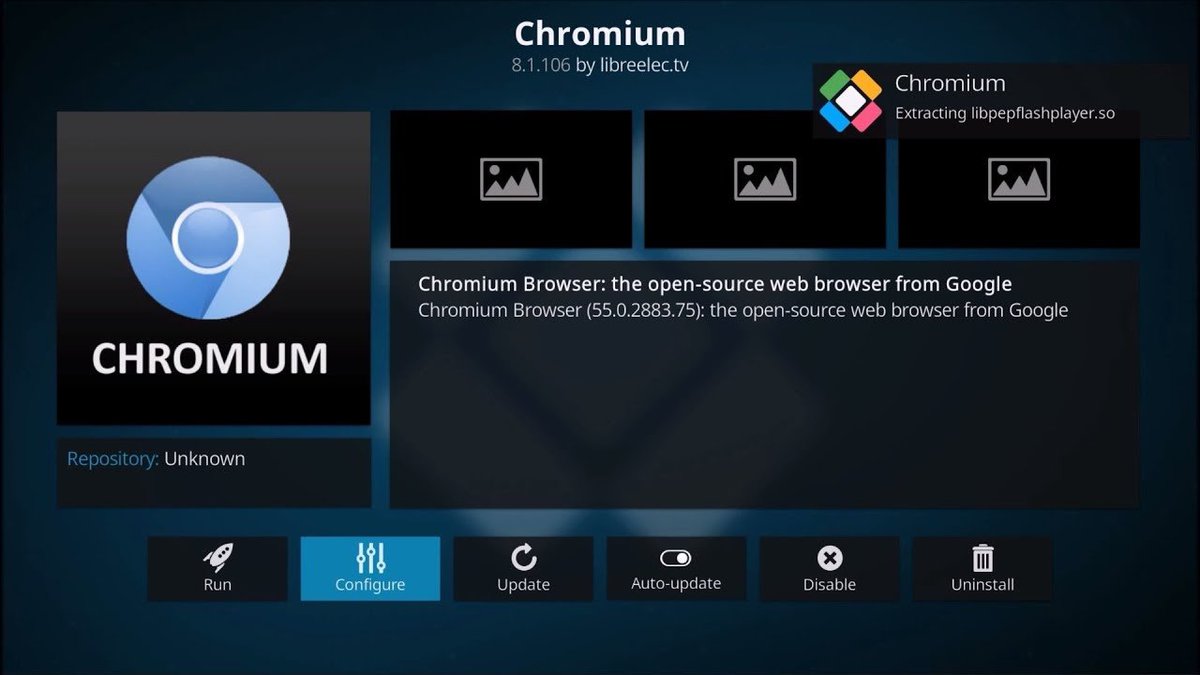
Insights of LIBREELEC OS
- You can install this OS within less than 20 minutes. It comes with clear instructions, an SD creator app, and an installer also.
- If you have experience running Kodi, you will be comfortable running this OS on your Raspberry.
- Boots up within a few seconds, and you can navigate and open media to consume without facing any trouble.
- Uses the stock Kodi and offers standard customizations. Besides, it has a bunch of add-ons available that you can install anytime.
- It is managed by a team of developers and ensures get updates every month.
- Working closely with Kodi and regularly patches while maintaining security remain the primary concern as always.
4. OSMC
This is the best Raspberry Pi OS if you are planning to work or manage media content. It is an open source software that renders a beautiful interface and easy-to-use features. To let you know, this software is based on Kodi OS, which is capable of providing support for virtually any media content.
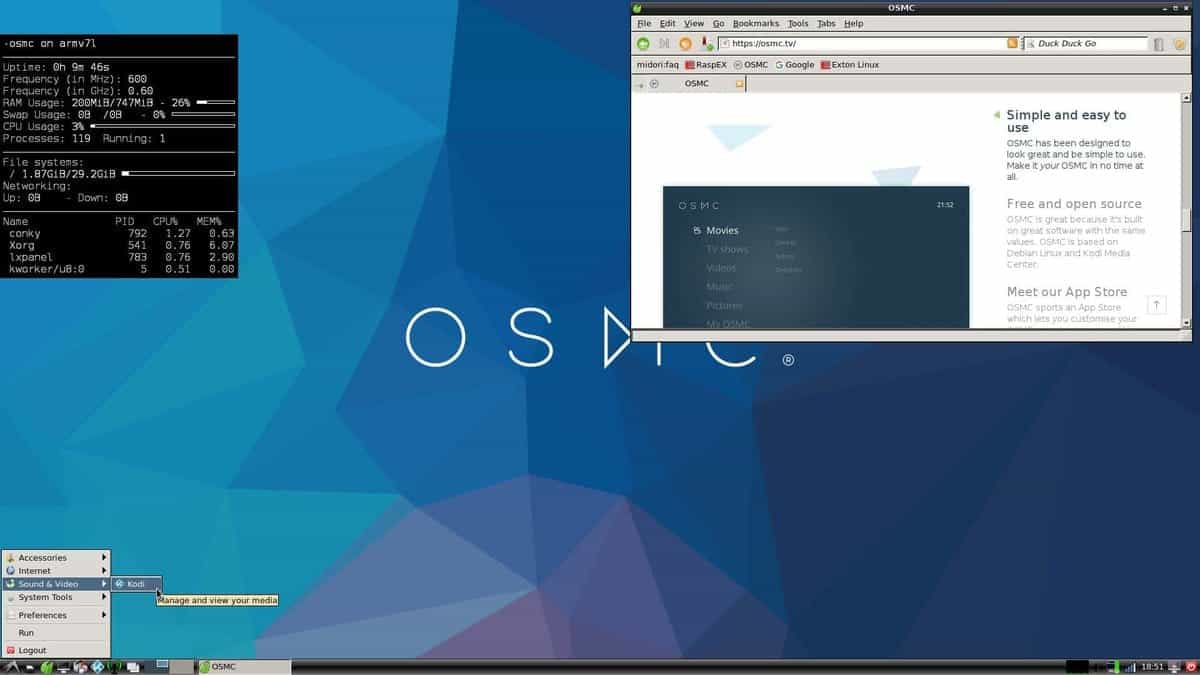
Insights of OSMC OS
- It comes with several customizable built-in images that allow Raspberry to produce high-quality videos, pictures, and other media content.
- It takes a short time to complete the installation, but you can set up an HTPC experience within a few minutes.
- Considered as the heir to OS like Raspbmc and Crystalbuntu. But the availability of a wide range of packages also increases its price.
- You will never need to update the OS manually. Instead, it will update itself automatically once every month.
- Offers a great application center like the google play store. You can download, install, and start using the required applications whenever you want.
5. RISC OS
There are many single-board computers and SoC that use ARM processors, such as Orange Pi, Raspberry Pi, Rockchip 3328, Qualcomm Snapdragon 410, and so on. RISC OS is the best Raspberry OS, intended to serve ARM processors. Enhances the performance and efficiency of the system as well.

Insights of RISC OS
- Designed by the original inventor of ARM. It is a unique open-source operating system for Raspberry Pi.
- You can not relate this OS to the Linux distribution system or Windows. Besides, it is maintained by a dedicated team of volunteers.
- If you are a newbie or have never worked with Raspberry, this might not be a suitable OS.
- RISC is very different from any kind of Linux distro or Windows available. It will take time to get used to the environment offered by RISC.
- It is a single-user OS and operates cooperative multitasking known as CMT. Secured from OS corruption and boot time is one of the fastest.
- Employing preemptive multitasking and multithreading, RISC has decided to remain with the CMT system.
6. Windows IoT Core
This is a powerful Raspberry Pi OS. Specially designed for writing sophisticated programs and making prototypes. It was intended to serve the developers and programmers. It has enabled coders to make IoT projects using Raspberry Pi and Windows 10. You can check a lot of Microsoft projects listed on their site.

Insights of Windows IoT Core OS
- This operating system focuses on security, connectivity, project development, and integration with the cloud.
- Unlike other OS listed in this article, you can not use it if you do not have Windows 10 running on your device.
- It comes with Microsoft Visual Studio, and you will have to use it to give any command or work with other applications.
- You will not perceive the full flavor of Windows Shell. Instead, it only allows a single Universal Windows Program application and background processes.
- It is compatible with ARM, and the IoT core can be used on SBCs like Raspberry Pi.
- IoT core can be blended with sensors like cameras, PIR sensors, servos, and temperature sensors to extend usability.
7. Lakka
Lakka is a great Raspberry Pi OS. If you plan to develop computer games or even play games on a single-board computer, you should try this OS. It can turn your Raspberry into a gaming console, and you will not even need a keyboard or mouse. Besides, it renders a beautiful user interface and a handful of customization features.

Insights of Lakka OS
- You can install it on your SD card easily, or if you want, you can use it running live.
- It can provide a great game controllers experience like PS4, Xbox, and Nintendo. But the OS is free and lightweight.
- Comes with a dedicated setup of hardware. If you do not own a computer or Raspberry, you can buy this set, which will cost only $30.
- It handles and processes computing power for running games using a libretro core. It is also the official OS of RetroArch and the libretro ecosystem.
- Allows the user to connect several USB joypads. It consumes less power and runs smoothly on Raspberry and other low-end hardware architectures.
- Developed and backed by a group of developers, designers, and gamers.
8. RaspBSD
It is an open-source image that comes from FreeBSD 11. The developers have preconfigured it in two images for use in Raspberry Pi. Although it does not work like a Linux distribution, it is pretty much the same. Berkeley Software Distribution invented it, and now it is one of the widely used single-board OS.

Insights of RaspBSD OS
- This operating system is very lightweight, and most of the popular game consoles use code such as PlayStation 4 and macOS.
- Intended to help newcomers to build projects using Raspberry Pie. Some packages even come with a preloaded image to start easily.
- This project is regularly updated and uses only publicly available tools.
- It comes with Openbox and the LXDE graphical desktop, alongside FreeBSD package repositories, which will be preconfigured.
Start using RaspBSD
9. RetroPie
It is another Raspberry Pi OS that has been built based on the Debian software library. RetroPie is the best OS for emulating retro games on a single-board computer like Raspberry, ODroid C1/C2, or even a PC. This OS provides a modern and user-friendly interface. RetroPie is the best emulator for the Raspberry Pi SBCs.

Insights of RetroPie
- RetroPie uses the EmulationStation frontend and SBC to generate the best retro gaming experience for its users.
- It comes with a special preloaded SD card image that can boot the OS without facing any trouble.
- It is one of the very few OS that can be operated by installing it on top of another operating system.
- It started its journey as an Emulation Station application but has now grown up to serve ARM-based devices.
- With the package, you will get themes for emulating IoT devices and running media players, and more than 50 other applications come pre-installed.
- You will be able to run x86 pc games using the emulator known as Exagear. But Raspberry Pi 3 Model B is advised to use for the best performance.
10. Ubuntu Core
Ubuntu is one of the most widely used operating systems all over the world. This Ubuntu version is designed to build and manage Internet of Things applications. This project is open source and backed by so many developers that you can not even imagine.

Insights of Ubuntu Core OS
- Ubuntu has 20+ other derivatives. So that if you decide to use Core, you will be a member of an active and welcoming forum.
- Covers the basic sets of the platform, services, and technologies to work more efficiently with IoT projects.
- This OS is lightweight and highly secure. Besides, you can restrict each application and its data from other applications.
- Focuses on meeting the requirement of IoT devices and their distributors.
- Public and private keys are generated, while two-step validation and authentication at every step make it more secure.
- Several snaps, like a core snap, a kernel snap, and a gadget snap, are used to build the Ubuntu Core system.
- You can distribute the application using Snaps, which makes it easy to distribute through Linux distribution from a play store.
11. Linutop
This is one of the prominent Raspberry Pi OS designed especially for people who want to start an Internet stall or digital marketing platform for their companies. It is based on Raspbian OS and is dedicated to rendering Web Kiosks or digital signage. Linutop is a small, lightweight OS and also comes with a hardware setup.

Insights of Linutop OS
- You can easily use this operating system on Raspberry Pi B, B+, and two and get a smooth performance.
- It is a perfect OS for running businesses such as hotels, restaurants, shops, city halls, offices, and museums.
- Linutop is a customized version of the same Linux distribution used by Xubuntu and Ubuntu/XFCE.
- Supports QC, a widget that allows the user to create cross-platform applications and graphical user interface in Raspberry Pi.
- Capable of running multimedia software and emphasizes secure web browsing on single-board computers.
- This OS lets you connect a mic for sound output. You can configure it to transform the system into an LTSP thin client if you want.
Start using Linutop
12. Kali Linux
Kali is one of the best Linux distributions available to run on Raspberry Pi. You will not get too many changes as any other ARM. This image can be used on desktop computers by upgrading to the full package known as Kali-Linux-full. You can use additional tools that are available on the website to extend the capabilities of certain features.
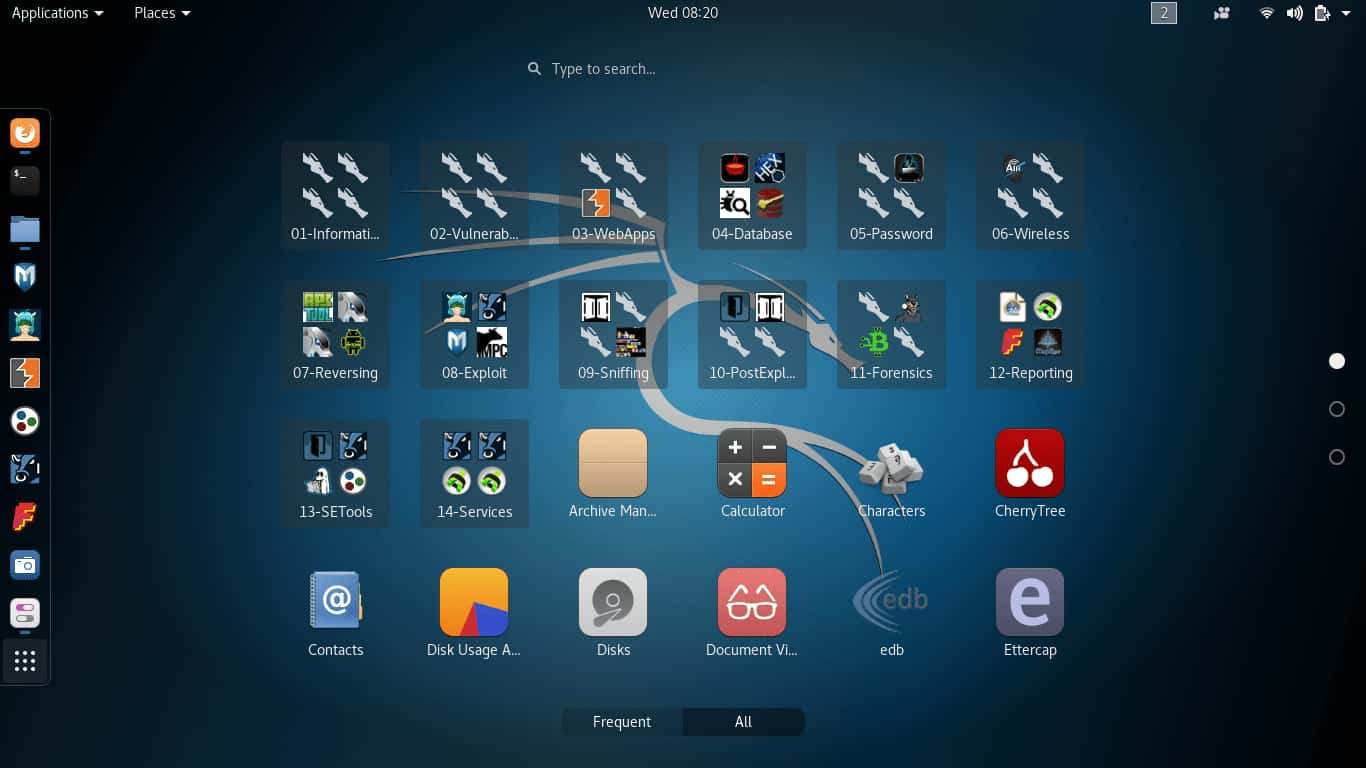
Insights of Kali Linux OS
- You will need a Class 10 SD card with at least 8GB of data storage for installing a prebuilt Kali Linux image on your Raspberry.
- This Debian-based distribution offers a lot of security and forensics tools to ensure your project or applications’ security.
- To accomplish your goal, you can ensure security through research, testing, forensic reports, or even reverse engineering.
- If you are a developer and desire to accomplish high computing projects, then Kali is the best choice for you.
- Besides, If you want to indulge in Ethical Hacking, Kali can help crack Wi-Fi passwords; spoofing and testing networks can be done.
13. Ubuntu Mate
Ubuntu became popular as soon as it started rolling on the market. So you can rely on the trustworthy community and their service. Ubuntu Mate is specially designed and dedicated to running on Raspberry Pi. It is a good choice for individuals looking for an alternative to Raspbian.
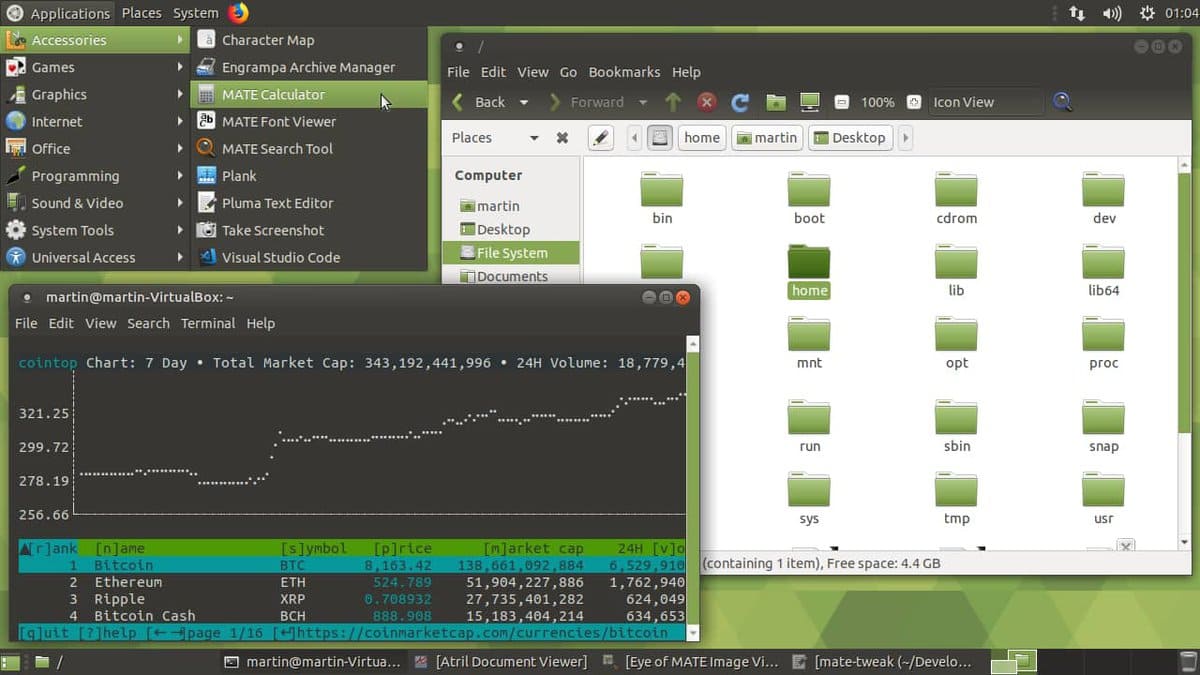
Insights of Ubuntu Mate OS
- Although it is a Debian-based Linux distribution, it gets updates faster due to its shorter development cycle.
- Although you can get a colorful interface, the best part is the features it offers: Raspbian, Minecraft Pi, or Scratch.
- There are small changes in the OS environment, but you can add the additional packages according to your demand using the apt command.
- The Ubuntu team maintains the kernel, and you will automatically get updates for expanding the file system.
- Comes with HDMI, WIFI, Bluetooth, and Ethernet support. Besides, it can encode and decode hardware-assisted video using FFmpeg.
- For providing GPIO access, GPIO Zero, pigpio, and WiringPi are available with the package alongside Python Wheels and USB Booting.
14. OpenMediaVault
It is another Debian-based program that is intended to improve network performance. Anyone looking to work with network drive or storage can pick this OS for running in Raspberry Pi. It started its journey back in 2009 and quickly grabbed the developer’s attention due to the plugins it was offering at that time.

Insights of OpenMediaVault OS
- You can update the OS using Debian Package Management. It performs well when it comes to web-based administration.
- Can be referred to as a great solution to use in any office or home. You can improve the performance by installing plugins from a vast collection.
- Delivers a NAS solution to the user as it offers services like SSH, FTP, TFTP, NFS (v3/v4), SMB/CIFS, and RSync.
- Supports traditional services of Raspberry Pi. You can extend the storage and take a backup of your files by inserting an SD card.
- You can build a web server using Nginx and MySQL plugins and configure the web interface offered by OpenMediaVault.
- Comes with Link aggregation, Wake On Lan, and IPv6 support. You can manage and share storage manually.
- Some of the best plugins available for OpenMediaVault OS are LVM, LDAP Directory Service, AFP, Bittorrent, DAAP, UPS, iSCSI Target, and Antivirus.
15. Gentoo
If you are looking for flexibility while building your project, then Gento can be the perfect OS for you. Served from Linux distribution, and it is intended to be very lightweight. You can install any package you want and use any service you want using this OS. Supported by Arch Linux, which is widely recognized for Raspberry Pi development.

Insights of Gentoo OS
- It has set a new standard for the top Raspberry Pi OS. It started its journey in 2000, and since then, it has seen major developments.
- You can run this operating system on your SBC without any trouble. You can add more functionalities using Emerge and Portage.
- Unlike other distributions, it compiles new applications locally on the computer.
- After downloading the new software, you can extract the source code and develop it according to your preference.
- Supported by onboard Raspberry Pi Ethernet, WiFi, and Bluetooth adaptors. You can manage packages using a ports-like system.
- Conditional dependencies, pre-package installation, installing software through sandboxing), and system profiles are some of the great services offered by Gento.
16. Kano
It can be referred to as an entirely planned and designed educational project for children. Kano manufactures computer kits to inspire children to learn how a computer works, write code or work with basic projects. Children and individuals are interested in developing art, music, apps, and games software can start with the starter kit distributed by Kano.

Insights of Kano OS
- Kano offers an open-source OS to use in Raspberry Pi, and you will be guided through a setup wizard after completing the installation.
- You will need to create an account and set a username to start the adventure. The OS comes with several story modes and a fresh set of features.
- Other applications like Minecraft, Youtube, and web browsers are also available. These most used applications are usually located on the menu.
- You can start building small projects right after installing the OS with the dedicated apps.
- This is a new kind of distribution. They have provided many books, resources, and instruction videos on their website to help you.
Start using Kano
17. Rokos
Cryptocurrency is the latest trending word in the technology field. Day by day, it is getting more popular among the general people and taking place in the world’s economy. As a result, the necessity to transform your computer into a miner node has reached to peak. We have seen many projects associated with cryptography in recent years, and Rokos is the best OS for this.

Insights of Rokos OS
- This OS offers a great solution to start crypto mining for people who cannot afford high-end computers or hardware.
- You will get support from creating your Bitcoin wallet or portfolio to start your first miner as well.
- You should not expect to start earning using Raspberry Pi, but still, this is an ideal OS to educate yourself.
- Comes with a fully functional Bitcoin and OKcash node. The OpenBazar server is also involved with the package.
- Focuses on updating security and regulations and optimizing the system regularly. Dependencies for compilation are also added.
18. Minibian
If you are using the official OS for Raspberry, you can give this OS a try. All the features and applications are packed into this minimalistic version of Raspbian. As it is developed and managed by the same team, it takes advantage of Raspbian. Still, it focuses on eliminating the unneeded apps to improve overall performance, although it does not offer a graphical user interface.

Insights of Minibian OS
- The environment of the Minibian is more stable but can provide a lightweight system for the embedded system.
- You can use the same repositories and binary projects like Raspbian. Besides, booting from an SD card image is easy.
- Not suitable for advanced projects and is less popular among developers. But this OS can provide an in-depth realization of the projects you are developing.
- Boot ability through network or ethernet is now available. Besides, a modern setup wizard will guide you through setting location, language, Wi-Fi, and updates.
19. Chromium OS
Google offers this open-source version of the Chromium OS. That was intended to use on Chromebook computers, but it is also available for Raspberry Pi. It can single-handedly convert your Raspberry Pi into a desktop PC as it allows users to run powerful applications using cloud computing rather than depending on hardware resources.

Insights of Chromium OS
- If you do not need anything else rather than web browsing, then a Raspberry Pi and Chromium OS are what you need.
- It comes with all the applications offered by Google, like Gmail, drive, access, docs, keeps, etc.
- Chromium can be used on Raspberry Pi 3 or 3B+ devices, as there are no images available for Pi Zero or Raspberry 4.
- After downloading the image, compress it into XZ format, which can be expanded in the Linux distribution system.
- You will need a Gmail account to get booting for the first time. The environment of the OS is pretty much different than what you have seen in Chromebook.
20. Alpine Linux
It is intended to serve the users who need more computational power. It is an independent Linux distribution that focuses on ensuring security, improving the system’s efficiency, and making the interface simple. If you plan to start a network project or work with VPN, Routers, and Firewalls, this is the best Raspberry Pi OS for you.

Insights of Alpine Linux
- The lightweight system has an image for Raspberry Pi, which will not occupy more than 50MB of your storage.
- You can build the system according to your demand and configure the applications of your choice.
- You can use their own APK management tool for upgrading the apps.
- It can be used as a workstation for XFCE, Firefox, and Linux software. But inventors of this OS also wanted to focus on working with embedded systems.
- Provides a noise-free Linux environment, while the binary package gives you more control over the system.
Finally, Insights
Raspberry Pi is the most attractive SBC among developers, programmers, and students. It helps to build prototypes and develop applications or software. Nowadays, Raspberry Pi can generate output like a desktop computer and has the ability to serve individuals and small businesses. Low power draw, small form factor, no noise, and solid-state storage are the main reasons behind the widespread use of Raspberry Pi.
You should pick the right OS that can accomplish your goal. You can choose any OS from the list of Raspberry Pi OS described above to have more control over the system and extend your Raspberry capabilities to a great extent.
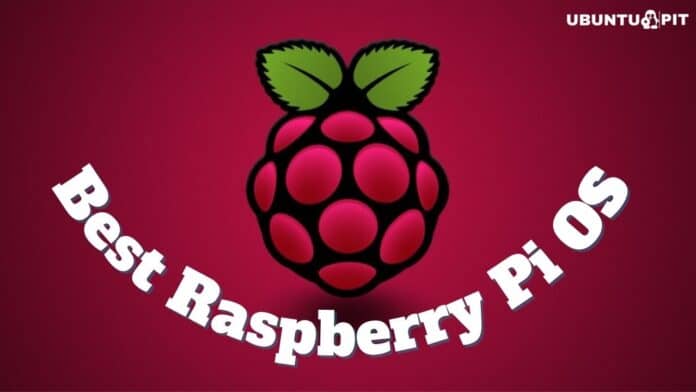


Just curious to know, even though there are so many OS options for RaspberryPi, official page for RaspberryPi lists select few set of OS. Why the same has been been added back to list under third party software under raspberrypi.org page (https://www.raspberrypi.org/software/operating-systems/#third-party-software) ?
Missing one of the best distro’s!! Manjaro
thanks for the great article! i think Raspbian is changing names to raspberry pi os. if so, changing the OS name in the article might improve the up to date feel of the article
Twister OS should be a close second to Raspbian. I like all the different flavors of Arch Linux and Ubuntu that can be installed as well. Not to mention the Debian desktops that can be installed on top of minimal Raspbian. Berryboot is something Rpi 4 users should check out. Many on this list aren’t worth wasting time on.
I am just a newbie with all the os’s on the list and it’s facinating to know that there are so many intelligent people out there to help people like me. Thank you so much and especially the “Open Source” programmers that have dedicated themselves to these different projects and are not focused on “money and greed” like Apple, Microsoft and Facebook and other Billionare corporate companies.
How did you get Apline to work on raspberry pi? Will not accept image for me on RPi4
for me it says NO SD CARD INSERTED
pi4
No Arch Linux? I’ve been using Arch on the Raspberry Pi ever since the first Pi came out in 2012.
And it’s derivative project, Manjaro. You can run Manjaro KDE ARM64 edition on Pi 4 with pretty good performance.
I had a very bad experience with Raspbian being corrupted after some unexpected shutdowns or after a couple of weeks turned off. Which option do you think is more resilient?
I don’t have theses kind of trouble for now with Rasbian…Maybe is your data support (USB key or micro SD card). Be sure to shutdown your Raspberry correctly by menu of Rasbian before completly shutting it down, and try to not remove frequently the container of the Rasbian OS image.
That can be due to powering down without a proper shutdown. You can, of course, destroy a MacBook or Windows PC by doing that. I recently had a 2019 MacBook Pro freeze while editing a court document. I was forced to shut down the Mac and restart. The file I was woking on was DOA. I had to spend hours cleaning up the mess left over from that shutdown. The lesson, computer memory is fragile. Back everything up often and don’t complain when a power fluctuation freezes your computer and crashes it. The problem wasn’t with Raspbian.
Those kind of destructive shutdowns don’t occur with Linux because it is all just text files there.
DietPi rules!
No DietPi? fast and stable and runs on loads of other SBCs as well
openELEC? really? the project has been abandoned for more then two years now…. I would rather take that from the list and instead put there dietPi for example.